In her first solo show at Bridgette Mayer Gallery (through Feb. 23), Shelley Spector includes a variety of objects that bridge the gaps between found art, domestic wares, and nostalgic trinkets. A series of prints and a room-sized installation round out the three-part, one-person exhibit that offers variety and depth.
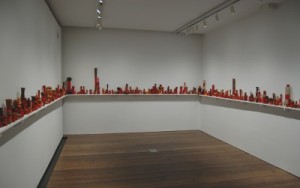
By far the largest one of Spector’s works is the project “Mariposa.” In the room farthest to the back of Bridgette Mayer, Spector lines the walls with a long, wraparound shelf located at waist level. On the shelf rest every shape, size, and composition of spools wrapped with bright red yarn. The spools are wooden but vary from light in color, to almost black. Some are coated in cracked and chipped paint, and one is even made from a corncob. This project began in the winter of 2010 when Spector began unraveling an old wool blanket that she had used for many years, which she found tucked away in a closet.
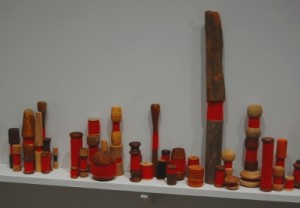
Through a literal process of deconstruction, the blanket begins to assume a new life, leading the artist through a journey of historical and personal examination. Instead of a functional cover, the fabric becomes an introspective artwork that provides comfort in a psychological way, much like its original manifestation provided physical snugness. During the march of our lives, the organization and plans we lay out often become unwound, redone, and unrecognizable. We can take solace in the fact that, no matter what shape things take, there are always intriguing and unique ways to perceive them; even when things seem irreparably changed, it does not necessarily define their value. Spector takes the name of the installation from the manufacturer’s tag she removed at the start of the project. In Spanish, “Mariposa” means butterfly, which is a more than apt metaphor for the act of transformation and renewal.
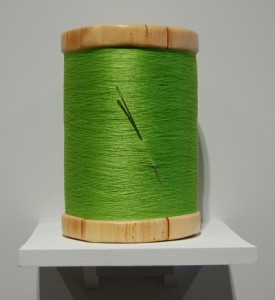
In the front part of the exhibition, the artist displays creations which seem in many ways to be inextricably linked to the process in “Mariposa.” As a sort of exploration of contrast, Spector offers an oversized spool of brilliant green thread, complete with a large needle slid through the wound-up fibers. The color scheme of this piece entitled “The Mend” is complimentary to the many red spools in her installation. If one were to mend a crimson blanket with this green thread, however, the patches and scars left over would be more than apparent – even jarring. Elsewhere she includes giant rulers, one complete with a level, which would seemingly help to measure her equally larger-than-life mending kit.
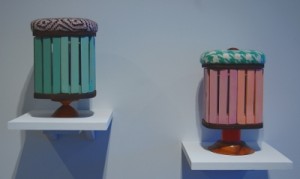
Other objects are less connected to the weaving and cloth ideas in the rest of the show or at least turn these themes on their head. A pair of wooden bird cages – one pink and one mint colored – have upholstered tops which seem more like pin cushions than the sculpture entitled “Pin Cushion” whose wooden form more resembles a butter-churner with a skirt; there appears to be no easy way to insert a pin into its form at all.
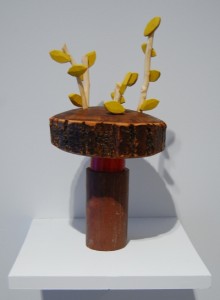
A tiny, wooden, Space Needle-like structure sprouts branches and chiseled, painted leaves, bestowed with the bittersweet title of “Tree Again.” Here Spector returns to the meandering and complex relationships surrounding rebirth, alteration, and inevitable change.
The third component of “But Not As Much As Tomorrow” is in the gallery’s vault space, a tiny room surrounded by 28 tall, vertical pigment prints entitled “Five And A Half By Forty” (the dimensions of the images). They depict all manner of household items, personal effects, and phrases which are surely meaningful to the artist in some way. These include a comb, a watch, a bobby pin, some National Geographic magazine spines, and many others. This collection of seemingly unrelated things helps to round out what culminates as a deeply personal and emotional show. Although it is object-based, Spector’s exhibit is far from materialistic. Nothing here even vaguely implies material desire and in many ways even touches on its antithesis. A frame with dollar-bill-text reading “I am here for you” asserts either the artist’s caring nature for the viewer or her peace of mind in accepting others’ good will. While the imagery of money generally calls to mind price, greed, or privilege, this manifestation extends only a helping hand.
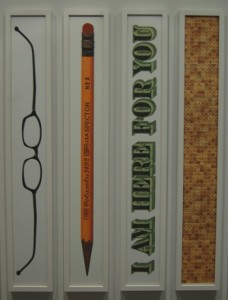
Shelley Spector introduces insights into her own life as well as the infinitely complex mechanisms that connect and define us all. Powerfully individual, “But Not As Much As Tomorrow” is also inherently communal and accessible. While a similar show could come across as egotistical or esoteric, Spector’s work is anything but selfish. In opening up her world to us, we come away with lucid new ideas about our own.
“Shelley Spector: But Not As Much As Tomorrow.” Bridgette Mayer Gallery, through Feb. 23.









